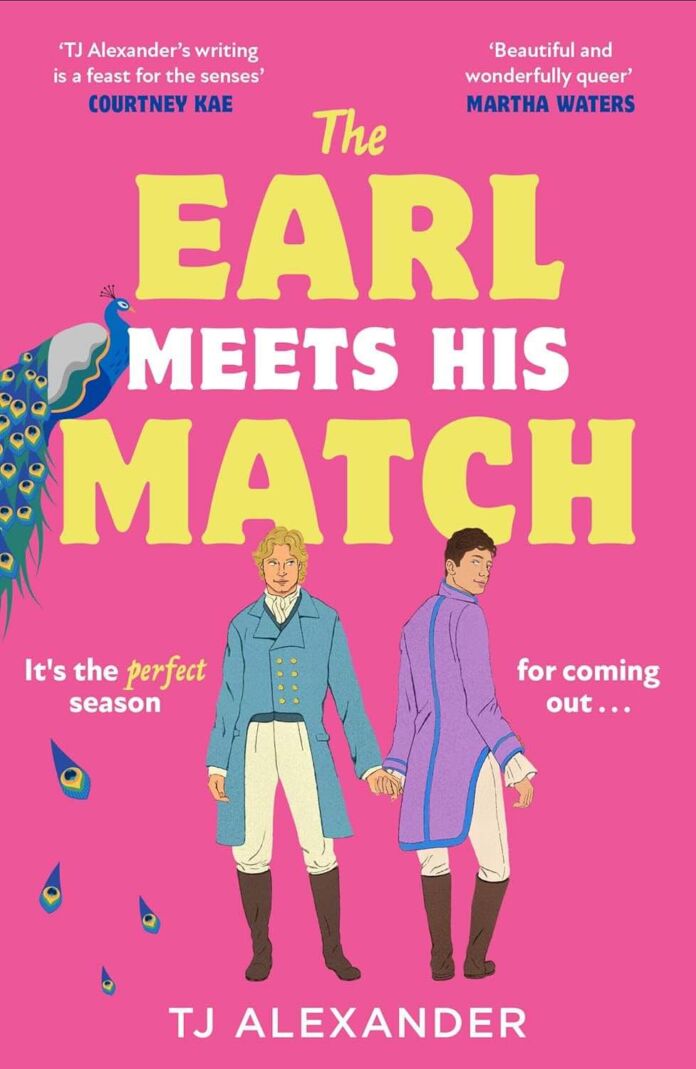In “The Earl Meets His Match,” T.J. Alexander delivers a refreshing and heartwarming queer historical romance that challenges conventions while honoring the beloved tropes of Regency fiction. Set in the early 1800s, this novel introduces us to Christopher Winterthrope, the reclusive Earl of Eden, who faces an impossible ultimatum: marry before his twenty-fifth birthday or lose his inheritance. When James Harding arrives as his new valet—mysterious, handsome, and frustratingly proper—neither man anticipates how deeply their lives will intertwine as they navigate society’s expectations and their own identities.
Alexander, known for contemporary queer romances like “Chef’s Kiss” and “Triple Sec,” makes a graceful transition to historical fiction while maintaining their talent for crafting authentic, emotionally resonant characters who leap off the page. What sets this novel apart is its exploration of gender identity in a historical setting, offering representation rarely seen in Regency romance while maintaining the witty banter and slow-burn romance readers adore from the genre.
Plot: A Dance of Identity and Love
The story begins at Eden Abbey, where Christopher, our reclusive protagonist, has created a sanctuary away from society’s prying eyes. His comfortable existence is threatened when his solicitors inform him that according to his father’s will, he must marry before his twenty-fifth birthday or forfeit his inheritance. This dilemma forces him to venture to London for the Season, but knowing his unique situation requires assistance, he reluctantly hires James Harding as his valet.
The narrative unfolds with rich complexity as Christopher and James navigate their growing attraction while maintaining strict boundaries between master and servant. Their relationship evolves from professional distance to grudging respect to deep friendship, all while Christopher pursues a suitable bride. The story takes a dramatic turn when James proposes a solution to Christopher’s marriage dilemma that would require enormous sacrifice, leading to a conflict that forces both men to confront what they truly value most.
Alexander weaves multiple storylines with dexterity—Christopher’s search for a bride, the blossoming romance between side characters Lady Belinda and poet Horace Chesterfield, and the central relationship between our protagonists. The plot builds to a satisfying conclusion that balances period authenticity with a happily-ever-after that feels both earned and believable within its historical context.
Characters: Beautifully Complex and Authentic
The true strength of “The Earl Meets His Match” lies in its characters, particularly our two protagonists:
- Christopher Winterthrope: The Earl of Eden is delightfully complex—simultaneously privileged and vulnerable. His isolation stems not just from social anxiety but from the fear of discovery, as he was assigned female at birth. Christopher’s journey from fearful seclusion to choosing love and authenticity over wealth and status is powerfully rendered. His eccentricities (his fondness for light-colored clothing, his devotion to his horse Orion, and his penchant for classics) make him endearing rather than precious.
- James Harding: Mysterious, competent, and reserved, James initially appears as the quintessential proper valet. As layers of his identity and history are revealed, he emerges as a deeply compelling character whose external composure masks internal conflicts. His backstory as Lady Constance, who disappeared from society to live authentically as a man, creates a fascinating parallel to Christopher’s own journey.
The supporting cast shines equally bright:
- Lady Belinda Greene: Far from a mere plot device, Belinda has her own compelling arc as she mourns her missing sister (who readers eventually discover is James) while pursuing forbidden love with a poet.
- Cook (Anne): The maternal figure who provides both culinary comfort and emotional support, representing the found family theme that runs through the novel.
- Plinkton: The elderly butler whose death becomes a pivotal moment for Christopher, forcing him to confront mortality and the importance of living authentically.
- Étienne Charbonneau: The flamboyant French tailor who creates specialized undergarments for Christopher and represents the broader queer community existing beneath society’s notice.
Writing Style: Witty and Evocative
Alexander’s prose balances period authenticity with modern readability, creating a narrative voice that feels both historically grounded and accessible. The dialogue sparkles with wit reminiscent of Jane Austen, while interior thoughts provide depth and vulnerability. Particularly impressive is how Alexander handles characters’ gender identities with sensitivity while maintaining period-appropriate language—a delicate balance executed with remarkable skill.
The author excels at creating evocative scenes, from the claustrophobic intimacy of hiding in Lady Belinda’s armoire to the terrifying storm sequences that haunt Christopher’s memories. Perhaps most effectively, Alexander crafts moments of quiet tenderness between Christopher and James that convey profound emotion through small gestures—a hand on a shoulder, a nighttime conversation, or the simple act of helping one another dress.
Themes: Identity, Freedom, and Chosen Family
“The Earl Meets His Match” explores several resonant themes:
- Authenticity versus Obligation: Both protagonists wrestle with societal expectations, with Christopher ultimately choosing personal freedom over inheritance and James offering to sacrifice his hard-won identity to help Christopher.
- Chosen Family: From Cook and Plinkton to the eventual partnership between Christopher and James, the novel celebrates relationships formed through choice rather than blood.
- Gender Identity in Historical Context: By exploring transgender experiences in the Regency era, Alexander reminds readers that queer people have always existed, even when lacking modern language for their identities.
- Class Boundaries: The master-servant relationship between Christopher and James creates tension that must be overcome for their romance to flourish, highlighting the period’s rigid social hierarchy.
Critique: A Few Minor Missteps
While “The Earl Meets His Match” is a captivating read, it does stumble occasionally:
- The pacing in the middle section feels somewhat uneven, with the elaborate deception to help Belinda elope taking perhaps more page time than necessary.
- Some historical details occasionally feel too modern in perspective, particularly regarding how openly characters discuss their identities.
- The central conflict’s resolution—abandoning the estate entirely—feels slightly rushed after spending much of the novel establishing Christopher’s connection to Eden Abbey.
- The villains (namely the Duke of Rushford) remain somewhat underdeveloped, functioning more as obstacles than fully realized antagonists.
However, these minor issues don’t significantly detract from the novel’s overall charm and emotional impact.
Final Thoughts: A Significant Addition to Queer Historical Romance
“The Earl Meets His Match” succeeds brilliantly at what it sets out to do—provide a swoony Regency romance featuring transgender protagonists without becoming didactic or anachronistic. It balances historical authenticity with modern sensibilities, creating a world where readers can believe in both the period setting and the characters’ journeys toward love and self-acceptance.
For readers of KJ Charles, Cat Sebastian, or Alexis Hall who have been seeking transgender representation in historical romance, this novel fills an important gap in the genre. Alexander has created a romance that stands proudly alongside other queer historical fiction while offering a unique perspective often missing from the category.
With its endearing characters, witty dialogue, and heartfelt exploration of identity, “The Earl Meets His Match” is an interesting read. The novel proves that historical romance can be both authentic to its period and inclusive of diverse experiences—and thoroughly entertaining throughout.
For Fans Of…
If you enjoyed “The Earl Meets His Match,” consider these similar titles:
- “A Lady for a Duke” by Alexis Hall (featuring a transgender heroine in a Regency setting)
- “The Gentleman’s Guide to Vice and Virtue” by Mackenzi Lee (queer YA historical fiction)
- “Band Sinister” by KJ Charles (queer Regency romance)
- “Any Old Diamonds” by KJ Charles (queer Victorian romance with class differences)
- Alexander’s own contemporary queer romances like “Chef’s Kiss” and “Chef’s Choice”
Whether you’re a devoted historical romance reader seeking more inclusive representation or simply looking for a well-crafted love story with depth and heart, “The Earl Meets His Match” delivers a reading experience as satisfying as it is significant.





